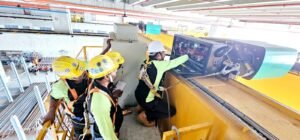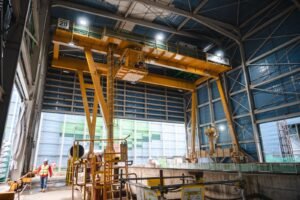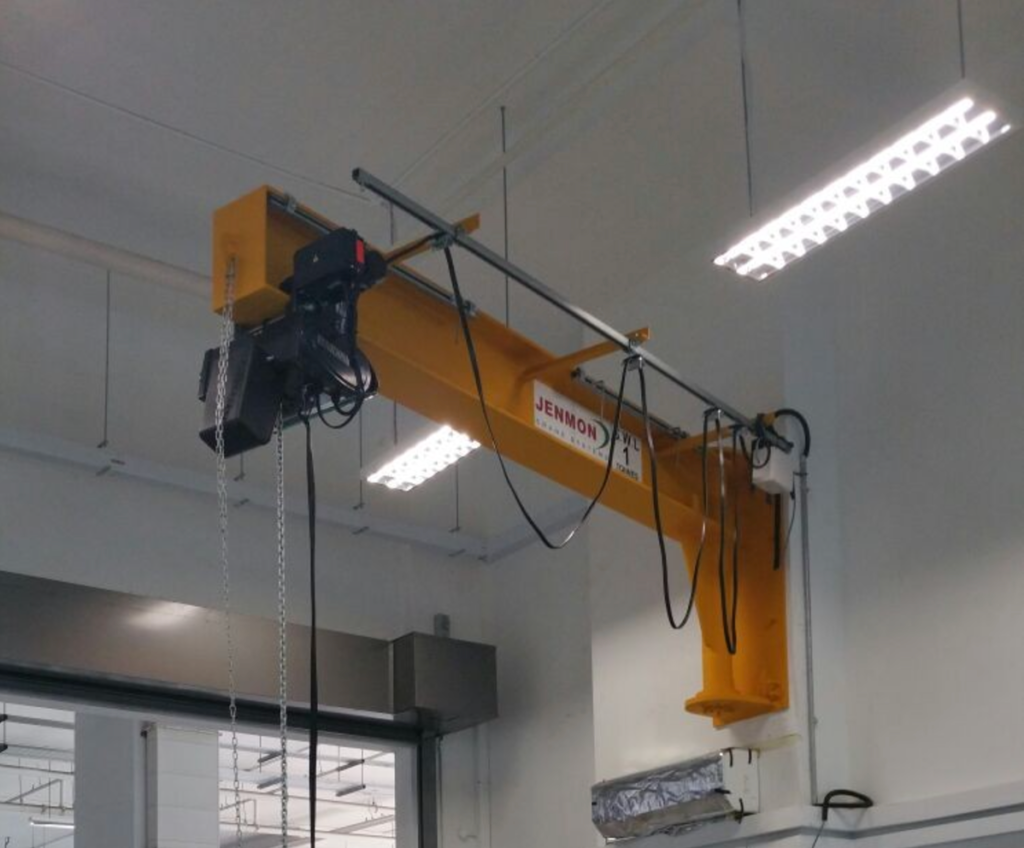Jenmon | Blogs
How to Choose the Right Wall Mounted Jib Crane for Your Industrial Needs
Material handling forms the backbone of every successful industrial operation. You face daily challenges moving heavy loads efficiently whilst maximising your workspace. A wall mounted jib crane offers an elegant solution to these problems. The lift is connected to the wall or a solid structure, allowing you to reach farther than other lifts, without covering the floor space. Cranes like these are usually found in workplaces where the room is limited.
The benefits speak for themselves. You save precious floor space, reduce worker strain through ergonomic design, and gain impressive lifting capacity. Your wall mounted jib crane becomes an extension of your existing material handling system. The load moves smoothly along the jib arm, giving you precise control over heavy materials. This smart approach to lifting transforms how your team approaches daily operations.
What Is a Wall Mounted Jib Crane?
A wall mounted jib crane consists of several key components working together seamlessly. The jib arm extends horizontally from your wall, whilst the column provides vertical support. The mount secures everything to your structure, and the slewing range determines how far the crane rotates. You control the lifting motion through a hoist system that travels along the jib arm.
These cranes differ significantly from pillar-mounted or articulating jib cranes. Your wall mounted jib relies on the existing building structure for support, eliminating the need for foundation work. The slewing capability typically covers 180 degrees, perfect for serving workstations along walls. This mounted configuration makes efficient use of your available space whilst delivering reliable lifting performance. Each component works together to create lifting equipment that enhances your operational efficiency.
Key Factors to Consider Before Choosing Your Jib Crane
- Load Capacity and Reach Requirements
You must understand your exact load capacity requirements before selecting any crane. Consider the heaviest items you’ll lift, measured in kg, and add a safety margin. The outreach determines how far from the wall you can position loads. Your application needs will dictate your requirements for both the maximum weight and working radius.
Precise coverage matters enormously in tight spaces. You need adequate radius to serve all workstations within the crane’s operational area. Calculate the maximum distance from your wall to the furthest lifting point. This measurement ensures your chosen crane provides complete coverage of your work area without compromising safety or efficiency.
- Space Constraints and Mounting Options
Your amount of floor space will guide you on the best way to wall-mount your equipment. Check the height of the ceiling, the quality of the walls, and if there are any obstructions to the way you operate.
Consider how the wall mounted jib integrates with existing equipment. You don’t want your crane sitting idle because poor planning creates operational conflicts. The structure supporting your crane must handle both the crane weight and maximum lifting loads. Wall-mounted systems require robust mounting points that distribute forces properly across your building’s framework.
- Rotation and Slewing Capabilities
The slewing angle affects how effectively your crane serves the work area. Most wall-mounted installations provide 180-degree rotation, covering a half-circle from the mounting point. Your slewing jib crane should operate smoothly throughout its entire range without binding or excessive effort.
Manual operation keeps costs down whilst providing excellent control over load positioning. You operate the slewing mechanism through simple controls that respond predictably to input. Consider how often you’ll rotate the crane during typical operations. Frequent slewing might justify investing in powered rotation systems for improved efficiency.
- Type of Hoist and Lifting Equipment Needed
Your choice between manual and electric hoists depends on lifting frequency and load weights. An electric hoist can help decrease operators’ fatigue and increase the speed of tasks that must be repeated. Chain hoists last for many years, but rope hoists are easier to operate safely on difficult items or sensitive products.
The trolley system determines how loads move along the jib arm. You might need vacuum lifters for handling sheet materials or specialised attachments for unique applications. Your lifting equipment must suit both the loads you handle and the working environment in which you operate. Consider future needs when selecting hoist capacity and features.
Benefits of a Wall Mounted Slewing Jib Crane
Your wall mounted slewing jib crane delivers cost-effective installation without extensive foundation work. High-quality components ensure reliable operation with minimal maintenance requirements. The ergonomic design reduces worker strain by bringing loads closer to comfortable working positions.
These jib cranes enable remarkable efficiency improvements in material handling operations. You eliminate unnecessary walking and manual carrying of heavy items. Productivity increases as workers focus on value-added tasks rather than struggling with awkward loads. The smooth handling characteristics reduce the risk of dropped materials and workplace injuries. Regular maintenance keeps your crane operating at peak performance for years of reliable service.
Jenmon’s Wall Mounted Jib Crane Solution
We provide rational and cost-effective handling equipment that requires no building modifications for installation. Our cranes suit numerous industries whilst maintaining compact dimensions. You can move loads in every direction within the crane’s working envelope. We design our jib cranes as perfect companions to overhead crane systems, creating comprehensive workshop coverage that increases autonomy and efficiency at every workstation.
We offer four distinct jib crane types to meet your specific needs. Our Wall-mounted Jib Crane fits onto walls or posts, serving a 180° section over spans reaching 7m. The Pillar-mounted Jib Crane mounts on columns with partial or full rotation capability, anchored independently from your building structure. Our Double arm Pillar-mounted Jib Crane provides 270° coverage with 7m span capability on both sides. The Wall-mounted Travelling Jib Crane combines 180° rotation with travel capability along your wall as required.
We provide optional equipment including Tight-Wire Festoon systems, Anchor Bolts, Rotation Stops, and Collectors. Each option enhances crane functionality for specific applications. Our engineering team helps you select the perfect configuration for your unique requirements.
Final Thoughts – Maximise Productivity with the Right Fit
Choosing the right jib crane requires careful consideration of load capacity, space constraints, and operational requirements. You must balance initial costs against long-term productivity gains. The wall mounted jib crane represents an ergonomic, reliable, and smart choice for modern industrial operations.
Your investment in quality lifting equipment pays dividends through improved efficiency and reduced workplace strain. The right crane transforms how your team approaches material handling challenges. Consider consulting with experienced professionals who understand the nuances of crane selection and installation.
Contact Jenmon for expert advice tailored to your specific application. Our team provides detailed quotes and technical guidance to ensure you select the perfect wall mounted jib crane solution for your industrial needs. Your productivity improvements begin with making the right choice today.




